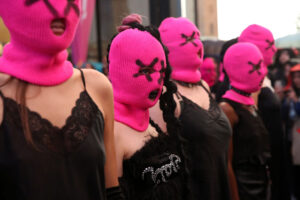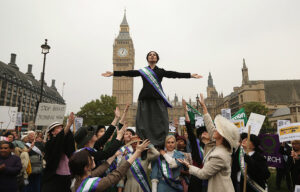Do you remember a time when women on television could be exhilaratingly rude about what other women looked like without everyone else being Deeply Disappointed? On Wednesday I had a flashback to this distant state of affairs as I saw several headlines featuring the words “Trinny and Susannah”.
Those iconic names thrust me back to 2003 or thereabouts, where — fag in hand on the sofa, bootcut trousers flapping round my ankles — along with much of the country I would find myself raptly watching two posh birds on telly, nominally talking about fashion. Each had a resting bitch face, stripy hair, and anhedonic drawl. In my memory, one of them is jabbing the other’s arm fat aggressively and saying her bracelet makes her look like a Roman Centurion going into battle. It really is true that you don’t know what you’ve got ‘til it’s gone.
The news stories this week — in the vaguest sense of “news” — were about the respective 20-something daughters of former What Not To Wear presenters Trinny Woodall and Susannah Constantine. Lyla (Trinny’s daughter) and Esme (Susannah’s) are apparently good pals, jointly occupying Tatler’s latest cover and giving an interview together.
Displaying the slavish respect for social etiquette we have come to expect from members of her generation, Lyla said of the pair’s more famous mothers: “I think they would be cancelled if the show was made now. You can’t really speak to people like that anymore and say things like, ‘You’re so ugly.’” She’s probably right, though. It certainly was a different time. Back then, we even called them Trinny and Tranny and nobody lost their jobs.
Checking in with the internet to remind myself of the details, I found myself gasping with laughter at the two presenters’ brutal summations, coming thick and fast as they comment on the secret filming of some poor schmuck before that week’s redemptive fashion makeover. Take Trinny to a sartorially challenged Church of England vicar: “Just because you wear a dog collar during the day doesn’t give you an excuse to look like a dog’s dinner at night.” Later on, Susannah tells the same woman that she looks like “Robin Cousins about to go onto the ice rink in those trousers”.
In another episode, Trinny says of an admin manager attempting to use quirky prints to distract from her large bosom: “To have a skyscraper on your left tit and a bridge on your right does nothing to detract from the size of your breasts.” But then again, they are just as critical about themselves. Susannah frequently unveils her wobbly tummy in order to poke and berate it for the benefit of viewers. The skeletal Trinny gamely does her bit too, persisting in the fiction that she is a “saddlebagger” with “thick calves” and “stumpy legs”.
As each presenter receives soul-crushing feedback from the other with serene equanimity, one wondered how they are still standing, let alone positively rocking a floaty skirt and knee-high boot. In one clip I watched, Susannah appraises a dress of Trinny’s thus: “Oh my god, I can’t bear to see it… look at your bottom… your bottom is just dribbling down the back of your legs, so we really are seeing the shortness of those little stumps.” Later on, Trinny tries to get her revenge, leaping on her co-presenter’s crop top: “You turn round and you see the tummy and you think urgh, that’s actually disgusting.”
The canonical story about What Not to Wear — emerging towards the end of its run and barely challenged since — was that the programme was viciously cruel and intensely classist, teaching a generation of young women to hate themselves. The sociologist Angela McRobbie has even written about its “post-feminist symbolic violence” towards working-class women, in the form of “public humiliation of people for their failure to adhere to middle-class standards in speech or appearance”.
She lists a number of the presenters’ most judgemental moments, describing them as “reminiscent of Fifties boarding school stories where the nasty snobbish girls ridicule the poor scholarship girl for her appearance, manners, upbringing, accent and shabbily dressed parents”. These include: “‘what a dreary voice’, ‘look at how she walks’, ‘she shouldn’t put ketchup on her chips’, ‘she looks like a mousy librarian’… ‘your hair looks like an overgrown poodle’, ‘your teeth are yellow, have you been eating grass?’ and ‘Oh My God… she looks like a German lesbian’”. Put like that, it does seem McRobbie might have a point.
And yet, viewed with the luxury of hindsight, more redeeming features of the programme emerge — especially when we think about what has come since. For one thing, it isn’t true that Trinny and Susannah were only savagely rude about working-class women. Middle-class and upper-class women would get the hose too; see the aforementioned vicar. The transgressively unrestrained jibes were equally distributed, it seemed to me.
Meanwhile the crudest caricatures, as the programme-makers plainly realised, were Trinny and Susannah themselves. Even McRobbie was forced to acknowledge the “degree of self-conscious irony” with which the pair lounged around, faces guarded and contemptuous, spitting out their damning verdicts in cut-glass tones with an air of pernickety feudal lords, assessing local girls with an eye to droit du seigneur. We were supposed to laugh at them rather than with them, and they knew it, hamming up the cold fish poshness to often hilarious effect.
But more than this: the conceit of the show was not that its hosts were perfect while other mere mortals were flawed. It was understood that every woman had “problem areas”, Trinny and Susannah included. Their big idea was that you didn’t need to change yourself by diet or exercise; all you needed was a bit of tailoring or strategically placed ruching to make the most of what nature gave you. Women are all in this together, was the underlying subtext, and every imperfection can be disguised with artful tricks. If you have big hips, relax; get a jacket that covers them and not a short one that cuts straight across. If you have massive knockers, lucky you; just step away from the polo necks and get something with a scooped front instead.
At base, Trinny and Susannah were exhorting women to face their fears about bodily imperfection and decrepitude, in the manner of psychoanalysts forcing a patient in denial to name out loud what scares her and so relieve it of its power. In later seasons, this tendency reached its peak with the concept of the 360° mirror. Before its pitiless gaze, some mortified woman would be unceremoniously deposited in bra and knickers, taking the hit for all of us as the hosts commented, poked, and prodded, before inevitably suggesting a trouser with a side zip.
I have no doubt that the women concerned absolutely hated it, but I don’t buy the wider complaint that the wrong message about size and shape was thereby sent to viewers. On the contrary — I think that most of us looked on with sympathetic fellow feeling, and came away with some relief and even hope. Instead of private, shame-filled self-chastisement about a particular problem area, perhaps we could just accept that everybody has one or two of the blasted things, then go shopping to celebrate.
Since then, officially sanctioned attitudes to female physiques have been revolutionised, with body positivity and self-acceptance the new bywords in places such as the BBC. For at least a decade, our progressive overlords have been furiously pretending that beauty standards for women are just radically contingent cultural norms; that if we all act like anything goes, then soon enough, it will.
Yet strangely, this doesn’t seem to have made women any more content. Cosmetic surgery is a growing trend even in the young, and there has been a recent large increase in the numbers of hospital admissions for eating disorders. We have invented a whole new set of fashionable ways for women and girls to punish themselves in the quest to meet, or escape, standards of physical perfection: chopping old bits off as well as inserting new ones, chemically removing appetites, fasting for days, or doing CrossFit ‘til you’re sick.
At the same time, evolving social mores have deprived us of the vocabulary to describe what it is we are running towards, or from: the basic knowledge that some faces and bodies are just more symmetrical, well-proportioned, and generally pleasing than others. Perversely, in well-intentioned attempts to deny this point, all we have managed to do is lose opportunities to cut its relative importance in life down to size.
After the demise of What Not to Wear, the televisual theatre of cruelty didn’t disappear, it just changed tack. Instead of watching a woman’s appearance being bitchily appraised for the purposes of cathartic female team-building, we started watching more fundamental aspects of people’s characters being demolished. Delusional would-be pop stars with no talent would be humiliated to tears by a pompous Simon Cowell; desperate and chaotic restaurant owners were screamed at by a psychopathic Gordon Ramsay. Instead of the jolly, bawdy identification of relatively trivial problems, fixable by a side zip or a bit of clever fabric-gathering, we got vulnerable people’s deep-seated character flaws and weaknesses, mercilessly exposed. But that’s progress for you.
Knowing their time was up, Trinny went off and founded a make-up empire — apparently succumbing to the lure of the plastic surgeon in the end, and thereby negating the central message of her old programme in the process. Susannah, meanwhile, has become a fabulous all-natural dowager-type on Instagram, grumpily hawking supplements on the balcony of her Greek villa and delivering vaguely depressive rants from the bath about the poor quality of M&S pyjamas. Her followers plainly adore her. What with Jilly Cooper’s Rivals now in vogue, and outrageous toffs apparently in the ascendancy once again, she should be resurrected as a national treasure forthwith.
But still, to me her golden age will always be alongside Trinny in the early Noughties, forming a comic televisual duo to rival the great Fanny and Johnnie Craddock in their campy hauteur. Search it out now: the perfect refuge from the boredom and oppression of today’s What Not to Say.
Disclaimer
Some of the posts we share are controversial and we do not necessarily agree with them in the whole extend. Sometimes we agree with the content or part of it but we do not agree with the narration or language. Nevertheless we find them somehow interesting, valuable and/or informative or we share them, because we strongly believe in freedom of speech, free press and journalism. We strongly encourage you to have a critical approach to all the content, do your own research and analysis to build your own opinion.
We would be glad to have your feedback.
Source: UnHerd Read the original article here: https://unherd.com/




